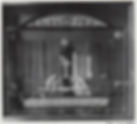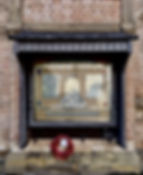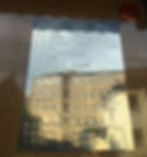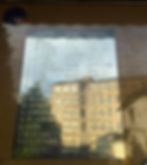
Commemorating the fallen from World War II (1939-1945) who had worked at Fox's and did not come home again
Fox's Works
World War Two Memorial

UNVEILING OF COMPANY’S WAR MEMORIAL
On the 11th November 1950, a memorial to employees of the local steel works who gave their lives in the 1939-45 war was unveiled during a simple but dignified ceremony at Fox’s General Offices.
The memorial plaque was made of stainless steel, and it was mounted on a mahogany base. The whole memorial, from its initial idea through to its completion, was the work of Fox’s employees.
The memorial was designed by George Birks, who worked in the Test House. In his own time he did the drawing and modelling for the memorial, and made the plaster cast. Along with two other employees, Mr. W. Simpson and Mr. G. Mosley, he spent a lot of time in the reproduction in stainless steel.
Work in the toolroom was supervised by Mr. A. Stenton and the memorial was encased by joiners B. D. Middleton and D. Beever, under the supervision of Ted Holdsworth. The Blacksmiths - H. Smith and C. Fletcher - also had a contribution, making the hooks upon which the emblems were hung. Overall, the memorial measured an impressive 6ft. by 5ft.
Common sights in the Works are depicted in an arc at the top, symbolising the departments in which the 39 men and women who were killed in the war had worked. Two figures symbolising the male and female sections of the Works kneel opposite each other, about to place the torch of freedom on the altar of sacrifice. In either corner there is a round silver medallion enamelled in different colours, representing the Navy, Army, Air Force and Merchant Navy. The names of the fallen are listed on the panels.
The Vicar of Stocksbridge, the Rev. D. V. Hewitt, dedicated the memorial. He said that the memorial would serve to remind everyone, as they went in and out of the works, of those who never came back. “Let it not be a mere empty remembrance” he said, “but each time we see this memorial let us remember that they died that we might live. They did not make that great sacrifice so that we could sit back and enjoy ourselves, live selfishly and live for ourselves alone. Let us resolve that we will bring into our lives that spirit of unselfish love and service which was brought out during the war in so many different ways and among so many different people.” The plaque was unveiled by Tom Mate, a Fox’s employee who lived at Haywoods Lane, Deepcar. Mr. Mate had lost two sons in the war, Thomas and Victor.
Wreaths were laid by Mr. S. R. Howes, the General Manager, Mr. S. R. Howes, with others from the British Legion and the wife and family of the late Sgt.-Nav. J. D. Shaw. Councillor Oliver Inman (Chief Engineer and Senior Resident Director) read the names of the fallen.
From an article printed in the Fox Magazine, Winter 1950, pp8-9
© Claire Pearson 2021
Click on a photograph to enlarge it

Published in the Fox Magazine Winter 1950 edition

Photo credit: Sally Jowitt November 2020

Photo credit: Sally Jowitt November 2020

Photo credit: Sally Jowitt November 2020

Photo credit: Sally Jowitt November 2020

Photo credit: Sally Jowitt November 2020

Some of these names can be found on the page "Some Stories of the Fallen of WWII"
The following article was written by Ella Jones.
THURGOLAND MEN FROM WW2 COMMEMORATED ON FOX’S WAR MEMORIAL
A few years ago, when checking on the condition of the WW2 memorial attached to the Victorian building in what is now Liberty Steels yard, I noticed that some of the names were the same as those on Thurgoland’s War Memorial. This is not really surprising since men from a wide area went to work at Fox’s.
There are four men listed as casualties who are on both memorials.
ORDINARY SEAMAN THOMAS BEET (BAR MILL)
The youngest was Ordinary Seaman Thomas Beet who was drowned, aged 19, when the Landing Gun Craft he was on, sailing from Harland and Woolf’s shipbuilding yard in Belfast to Cornwall sank on Easter Sunday, 25 April 1943.
HMLCG (L) 16 along with its sister craft LCG 15 were badly designed for sailing in rough seas and this they met when off the Pembrokeshire coast. For some unexplained reason, the boats were refused entry to Fishguard Harbour so went on hoping to reach the safety of Milford Haven. Unfortunately, conditions worsened and the vessels began taking on water. They radioed for help but the nearest lifeboat, at Angle, was out of commission and the St. David’s lifeboat was not called out till six hours later. It took them 2 ½ hours to reach the crafts - by then it was dark, and nothing could be done.
LCS16 sank with a loss of all hands. Some of the bodies were washed up in Freshwater Bay and were buried in various cemeteries, many at Milford. Several bodies were never found, including OS Beet’s and the site is now a war grave.
Thomas Beet is remembered on the Plymouth Naval Memorial as well as Thurgoland’s and Fox’s Memorials. He had worked in the Bar Mill at Stocksbridge.
PRIVATE STANLEY ILLINGSWORTH (BILLET MILL)
Pvte: Stanley Illingsworth initially served in the KOYLI (King’s Own Yorkshire Light Infantry) but was then transferred to the 9th Btn: Durham Light Infantry to make up strength of numbers when this battalion was deployed in the D-Day landings on 6th June 1944. The men landed on Gold Beach (King sector) and fought their way inland towards Bayeux and Caen.
Pvte: Illingsworth was killed on D Day+8 when the battalion was involved in heavy fighting against crack Panzer Lehr troops defending a village, Lingevres, in Normandy. The Normandy Bocage was very difficult terrain as it consisted of small fields surrounded by deep, sunken lanes and high, impenetrable hedges.
He was only 20 when killed and is buried in Bayeux War Cemetery, Calvados Region. This was created post-war when bodies from the surrounding area were brought there.
His headstone inscription reads: "In Loving Memory of my dear son killed in action. Always in our thoughts."
Pvte: Illingsworth is named on Fox’s War Memorial as he worked in the Billet Mill.
The final pair of men were not killed in action but none-the-less were casualties of the war.
GUNNER ROBERT STAGG (WIRE MILL)
Gunner John Robert Stagg served in a Light Anti-aircraft Regiment of the Royal Artillery. He was based in Scotland most likely protecting the ship building yards at Grangemouth on the R. Forth.
He died aged 22, on 21st January 1943 at Base Hospital, Larbert near Falkirk. His death certificate states his cause of death was: “Traumatic pneumonia (motorcycle accident), Ruptured spleen and Splenotomy” [an operation on the spleen]
Gunner Stagg had been employed in the Wire Mill at Fox’s.
He is buried in Thurgoland Cemetery and the inscription on his headstone reads, “In Memory of my Dearest Husband. Beloved, Yours the Beginning not the End.”
He had married Freda (Roberts) of Deepcar in 1940 and they had a daughter in 1942.

Gunner John Robert Stagg's C.W.G.C. headstone in Thurgoland cemetery. Photo: Sally Jowitt 2020.
GUNNER DOUGLAS MATTHEWMAN (WIRE MILL)
Gunner Douglas Matthewman enlisted in the Royal Artillery in 1939 having previously worked as a clerk in Fox’s Wire Mill. He is remembered on Fox’s War Memorial.
He had married in 1942 and at the time of his death was living in Monkseaton, Northumberland.
Gunner Matthewman became ill and was discharged from the army. He died in the Royal Infirmary, George Square, Edinburgh on 12 August 1943 aged 23. The cause of death is given as, “Multiple Polyps of Colon and Rectum. Post-operative cardiac failure.” [a modern diagnosis suggests Bowel Cancer]